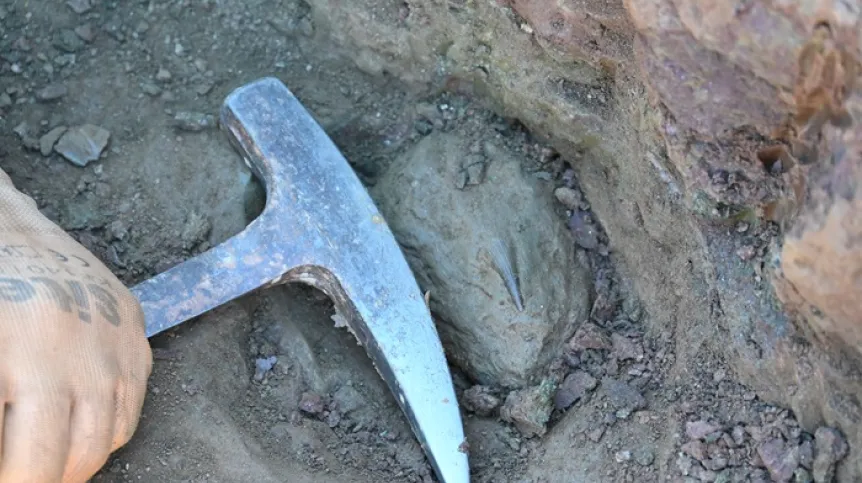
Palaeontologists discovered over 100 bones of terrestrial and marine animals from 240 million years ago each week during excavations at a site in Miedary (Silesia). Researchers are particularly pleased with several dozen well-preserved shark teeth.
The 10th excavation season in Miedary has ended. Four weeks ago, several palaeontologists and over 50 students (from Poland and abroad, including England and Catalonia) excavated about 50 cubic meters of sediments during two two-week sessions.
Medary is one of the Polish palaeontological sites with the greatest potential, scientists point out. The fossils come from the Middle Triassic, 240 million years ago (i.e. the time before dinosaurs took over the world) and belong to both land and marine animals.
Palaeontologists consider this year's excavation season a success; they are happy about the 'good catch'. They discovered over 100 bones every week; practically not an hour would pass without a new specimen. A large group of fossils were fish teeth, including - as they describe - an 'avalanche' of shark teeth.
'This year, we managed to go deeper into the rock profile of this site; we reached a layer that we had not known existed before. It was there that we saw a great many teeth of various types of fish, primarily sharks. And although they were quite common at this site, we have never had such a richness of species here before', says Adam Rytel, a doctoral candidate at the Polish Academy of Sciences’ Institute of Palaeobiology and one of the coordinators of the excavations.
'At some point we stopped counting them', adds Dr. Mateusz Tałanda from the Institute of Evolutionary Biology at the University of Warsaw, also one of the coordinators of the project.
According to Tałanda, in those times and in this area sharks were not the terror of the seas, but rather 'small fish' that fled from large predators. 'The teeth we found are over one centimetre wide, which is a large size for sharks from that period, because these animals were usually up to a meter long. Perhaps among them we will find teeth of a species that we do not know yet', says Tałanda.
The state of preservation of these teeth is very good, 'much better than those from previous years'. Many of them have been preserved in their entirety.
Palaeontologists also found a complete skull with teeth of a marine reptile - a nothosaurus. 'These reptiles were quite common in this part of Europe at that time, but this is the first such well-preserved skull found in Poland. Thanks to it, we will be able to learn more about nothosaurs, because the skull can tell us a lot about the biology of extinct animals, their diet, behaviour, the development of individual senses, and their relationships with other similar forms', says Rytel.
There was no shortage of fossils of terrestrial animals. 'This year, we found a lot of bones from a group of terrestrial reptiles that we had not found here before. This group is procolophons, which resembled today's agamas, small lizards', adds Tałanda.
Work at the site is often very demanding physically. Although an excavator helped to remove the highest layer of sediments, in order to get to the fossils, researchers first use pickaxes, shovels, and hammers, and then chisels, brushes, and needles. In addition, some bone clusters, together with the surrounding sediment and the protective plaster, can weigh tens or even hundreds of kilograms.
After the excavation work is completed, all specimens are sent from the field base to a storage, where they are sorted. Their research value is also determined there.
Further work involves, for example, mechanical removal of sediment, viewing microscopic specimens under an electron microscope, and scanning some specimens in a computer tomography scanner. It is also necessary to work with the literature and in foreign museum collections, thanks to which it is possible to identify similar animals from other parts of the world.
Recently, palaeontologists organized a temporary exhibition at a local school (Zbrosławice commune in Tarnowskie Góry district, Silesia) to celebrate the 10th anniversary of the excavations. They would like some of the specimens to be permanently exhibited there in the future.
This year's excavations were supervised by scientists from the Institute of Palaeobiology at the Polish Academy of Sciences (Dr. Tomasz Sulej, a professor at the Institute of Palaeobiology PAS; Dr. Łukasz Czepiński, doctoral candidate Adam Rytel) and the Institute of Evolutionary Biology at the University of Warsaw (Dr. Mateusz Tałanda, doctoral candidate Wojciech Pawlak). (PAP)
PAP - Science in Poland, Agnieszka Kliks-Pudlik
akp/ zan/ lm/ kap/
tr. RL













